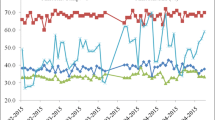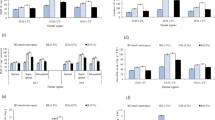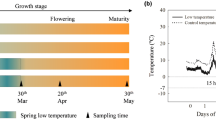Abstract
Boron is beneficial element can help plants face chilling stress. This research was arranged using factorial experiment based on randomized complete block design on Lycopersicon esculentum var. Infinity in Isfahan University of Technology due to having a new idea about bottom-cold and cold-air stress tomato seedling with boron application. There were two treatments having different boron (B1) concentrations (B1) 50.5 mM, and (B2) 75.82 mM. Three temperature treatment used as following: (1) the cold treatment used with vegetation chambers with low temperature (10 °C) (cold air), (2) the low nutrient solution (10 °C) temperature but the aerial part exposed to optimum temperature (bottom-cold) and (3) the last part, was the control plant (opt) keep in optimum root and shoot temperature (22 °C). Some physiological and biochemical characteristics were measured. The results were shown that boron uptake decreased in cold or stress as well as the water status of the plant which is suffering from cold-air stress greater than bottom-cold. Boron application, especially in higher concentration, improved some deleterious effect of cold stress, especially in the bottom-cold. The reason may refer to keeping photosynthesis traits in better level with B application. Cold-air stress, increased stress indices such as antioxidant and proline as well as glucose level and saturated/unsaturated fatty acid greater than bottom-cold stress. It was concluded that tomato was more resistant to bottom-cold stress than cold-air stress. Boron application increased the boron of leaves more effectively in the bottom-cold consequently increase plant tolerance to a chilling condition at the bottom-cold too.






Similar content being viewed by others
Abbreviations
- B:
-
Boron
- Ψleaf:
-
Leaf water potential
- EL:
-
Electrolyte leakage
- RWC:
-
Relative water content
- CF:
-
Chlorophyll fluorescence
- Chi:
-
Chlorophyll index
- DW:
-
Dry weight
- LST:
-
Shoot zone
- LRT:
-
Root zone
- Pn:
-
Photosynthesis
- gs:
-
Stomatal conductance
- Ci:
-
CO2 intracellular of stomata
- FA:
-
Fatty acid
- MDA:
-
Malondialdehyde
- RCBD:
-
Randomized complete block design
References
Adams SH, Stanhope KL, Grant RW, Cummings BP, Havel PJ (2008) Metabolic and endocrine profiles in response to systemic infusion of fructose and glucose in rhesus macaques. Endocrinol 149:3002–3008
Aghaee A, Moradi F, Zare-Mavian H, Zarinkamar F, Pour-Irandoost H, Sharifi P (2011) Physiological responses of tow rice (Oryza sativa L.) genotypes to chilling stress at seedling stage. Afr J Biotechnol 10(39):7617–7621
Ahmadi A, Siosemardeh A (2005) Investigation on the physiological basis of grain yield and drought resistance in wheat: leaf photosynthetic rate, SC, and non-stomatal limitations. Int J Agric Biol 7(5):807–811
Annikki W, Moritz T, Palva ET, Junttil O (2002) Independent activation of cold acclimation by low temperature and short photoperiod in hybrid aspen. Plant Physiol 129:1633–1641
Anonymous (2008) Pakistan fertilizer related statistics. National Fertilizer Development Centre (NFDC), Islamabad
Arato A, Bondarava N, Krieger-Liszkay A (2004) Production of reactive oxygen species in chloride and calcium-depleted photosystem II and their involvement in photoinhibition. Biochem Biophys Acta 1608:171–180
Aroca R, Tognoni F, Irigoyen JJ, Sanchez-Diaz M, Pardossi A (2001) Different root low temperature response of two maize genotypes differing in chilling sensitivity. Plant Physiol Biochem 39:1067–1073
Aroca R, Irigoyen JJ, Sanchez-Diaz M (2003) Drought enhances maize chilling tolerance. II. Photosynthetic traits and protective mechanisms against oxidative stress. Physiol Plant 117:540–549
Bates LS, Waldren RP, Teare ID (1973) Rapid determination of free proline for water-stress studies. Plant Soil 39:205–207
Bellaloui N, Mengistu A, Fisher DK, Abel CA (2012) Soybean seed composition as affected by drought and Phomopsis in phomopsis susceptible and resistant genotypes. J Crop Improv 26:428–453
Biddington NL, Dearman AS (1985) The effect of mechanically induced stress on the growth of cauliflower, lettuce and celery seed-lings. Ann Bot 55:109–119
Bloom AJ, Zwieniecki MA, Passioura JB, Randall LB, Holbrook NM, St Clair DA (2004) Water relations under root chilling in a sensitive and to lerant tomato species. Plant Cell Environ 27:971–979
Bradford MM (1976) A rapid and sensitive method for the quantitation of microgram quantities of protein utilizing the principle of protein-dye binding. Anal Biochem 72:248–254
Cakmak I, Omheld V (1997) Boron deficiency induced impairments of cellular functions in plants. Plant Soil 193:71–83
Cakmak I, Kurz H, Marschner H (1995) Short-term effects of boron, germanium and high light intensity on membrane permeability in boron deficient leaves of sunflower. Physiol Plant 95:11–18
Chang M, Chen S, Lee S, Chen Y (2001) Cold-acclimation and root temperature protection from chilling injury in chilling-sensitive mung bean (Vigna radiata L.) seedlings. Bot Bull Acad Sin 42:53–60
Chen B, Saltveit ME, Beckles DM (2019) Chilling-stress modifies DNA methylation level in cucumber (Cucumis sativus L.) seedling radicle to regulate elongation rate. Sci Hortic 252:14–19
Demiray H, Dereboylu AE, Altan F, Zeytünlüoğlu A (2011) Identification of proteins involved in excess boron stress in roots of carrot (Daucus carota L.) and role of niacin in the protein profiles. Afr J Biotechnol 10(69):15545–15551
Dixit D, Srivastava NK, Sharma S (2002) Boron deficiency induced changes in translocation of 14CO2 photosynthate into primary metabolites in relation to essential oil and curcumin accumulation in turmeric (Curcuma longa L.). Photosynthetica 40:109–113
Filella I, Llusia J, Pin JO, Pen JU (1998) Leaf gas exchange and fluorescence of Phillyrea latifolia, Pistacia lentiscus and Quercus Ilex saplings in severe drought and high temperature conditions. Environ Exp Bot 39:213–220
Frommer WB, von Wiren N (2002) Ping-pong with boron. Nature 410:282–283
Gilmour SJ, Sebolt AM, Salazar MP, Everard JD, Thomashow MF (2000) Overexpression of the Arabidopsis CBF3 transcriptional activator mimics multiple biochemical changes associated with cold acclimation. Plant Physiol 124:1854–1865
Hajiboland R, Farhanghi F (2010) Remobilization of boron, photosynthesis, phenolic metabolism and anti-oxidant defense capacity in boron deficient turnip (Brassica rapa L.) plants. Soil Sci Plant Nut 56:427–437
Han S, Chen L, Jiang H, Smith BR, Yang L, Xie C (2008) Boron deficiency decreases growth and photosynthesis and increases starch and hexoses in leaves of citrus seedlings. Plant Physiol 165:1331–1341
Hannan MM, Ahmed MB, Razvy MA, Karim R, Khatun M, Haydar A, Hossain M, Roy UK (2007) Heterosis and correlation of yield and yield components in tomato (Lycopersicon esulentum Mill.). Am Eurasian J Sci Res 2(2):146–150
Huang L, Bell RW, Dell B (2001) Boron supply into wheat (Triticum aestivum L. cv. Wilgoyne) ears whilst still enclosed within leaf sheath. J Exp Bot 52:1731–1738
Ingram J, Chandler JW, Gallagher L, Salamini F, Bartels D (1997) Analysis of cDNA clones encoding sucrose-phosphate synthase in relation to sugar interconversions associated with dehydration in the resurrection plant Craterostigma plantagineum Hochst. Plant Physiol 115:113–121
Jeanine MD, Douglas CS, Paul VN, Laura L, Wade JS (2003) Boron improves growth, yield, quality and nutrient content of tomato. J Am Soc Hortic Sci 128(3):441–446
Jones JB (2005) Hydroponics: a practical guide for the soilless grower. CRC Press, USA, p 440
Kaur G, Kumar S, Thakur P, Malik JA, Nayyar H (2011) Involvement of proline in response of chickpea (Cicer arietinum L.) to chilling stress at reproductive stage. Sci Hortic 128(3):174–181
Koç E, İşlek C, Üstün AS (2010) Effect of cold chlorophyll content of hot pepper (Capsicum annuum L.) varieties. GUJ Sci 23(1):1–6
Koleva II, van Beek TA, Linssen JPH, de Groot A, Evstatieva LN (2002) Screening of plant extracts for antioxidant activity: a comparative study on three testing methods. Phytochem Anal 13:8–17
Liu P (2000) The effect of molybdenum and boron on nutritional and physiological mechanism of yield and quality in soybean. Dissertation, Zhejiang University
Liu P, Yang YS, Xu GD, Yang YA, Fang YH, Kalin RM (2005) The effect of molybdenum and boron in soil on the growth and photosynthesis of three soybean varieties. Plant Soil Environ 51:197–205
Lu C, Huang B (2003) Effects of boron on membrane lipid peroxidation and endogenous protective systems in leaves of Eucalyptus grandis×Eucalyptus urophylla under low temperature. J Trop Subtrop Bot 11:217–222
Lukaszewski KM, Blevins DG (1996) Root growth inhibition in boron deficient or aluminum-stressed squash may be a result of impaired ascorbate metabolism. Plant Physiol 112:1135–1140
Lutts S, Kinet JM, Bouharmont J (1995) Changes in plant response to NaCl during development of rice varieties differing in salinity resistance. J Exp Bot 46:1843–1852
Maria A, Equiza B, Juanp M, Jorge A, Tognett A (2001) Morphological, anatomical and physiological responses related to differential shoot vs. root growth inhibition at low temperature in spring and winter wheat. Ann Bot 87:67–76
Marschner H (1995) Mineral nutrition of higher plants. Academic Press, USA, p 672
Marzanna S, Mieczysław K, Maria K, Balska Z, Alina K (1999) low temperature affects pattern of leaf growth and structure of cell walls in winter oilseed rape (Brassica napus L., var. Oleifera L.). Ann Bot 84:313–319
Matzner S, Comstock J (2001) The temperature dependence of shoot hydraulic resistance: implications for stomatal behaviour and hydraulic limitation. Plant Cell Environ 24:1299–1307
McAdam SA, Manzi M, Ross JJ, Brodribb TJ, Gomez-Cadenas A (2016) Uprooting an abscisic acid paradigm: shoots are the primary source. Plant Signal Behav 11:652–659
Mohabbati F, Paknejad F, Vazan S, Habibi D, Tookallo MR, Moradi F (2013) Protective effect of exogenous PGRs on chlorophyll fluorescence and membrane integrity of rice seedling under chilling stress. Res J Appl Sci Eng Technol 5(1):146–153
Motamedi M, Haghighi M, Goli AH (2019) Physiological changes of sweet and hot peppers in vegetative and reproductive growth stages treated by Ca and H2O2 under unforeseen heat stresses. Sci Hortic 249:306–313
Papadakis IE, Dimassi KN, Bosabalidis AM, Therio IN, Angelos P, Giannakoula A (2004) Boron toxicity in Clementine mandarin plants grafted on two rootstocks. Plant Sci 166:539–547
Paredes M, Quiles MJ (2017) Chilling stress, and hydrogen peroxide accumulation in Chrysanthemum morifolium and Spathiphyllum lanceifolium involvement of chlororespiration. J Plant Physiol 211:36–41
Paul MJ, Driscoll SP, Lawlor DW (1991) The effect of cooling on photosynthesis, amounts of carbohydrate and assimilate export in sunflower. J Exp Bot 42:845–852
Phillips JR, Oliver MJ, Bartels D (2002) Molecular genetics of desiccation and tolerant systems. In: Black M, Pritchard H (eds) Desiccation and survival in plants: drying without dying. CAB International, Wallingford, pp 319–341
Phornvillay S, Pongprasert N, Wongs Ch, Apiradee A, Uthairatanakij V (2019) Exogenous putrescine treatment delays chilling injury in okra pod (Abelmoschus esculentus) stored at low storage temperature. Sci Hortic 256:108550–108559
Polic D, Lukovic J, Zoric L, Boza P (2009) Morpho-anatomical differentiation of (Suaeda maritime L.) Dumort. 1827, (Chenopodiaceae) populations from inland and maritime saline area. Cent Eur J Biol 4:117–129
Rutten D, Santarius KA (1992) Relationship between frost tolerance and sugar concentration of various bryophytes in summer and winter. Oecologia 91:260–265
Starck Z, Niemyska B, Bogdan J, Akour Tawalbeh RN (2000) Response of tomato plants to chilling stress in association with nutrient or phosphorus starvation. Plant Soil 226:99–106
Sterrett SB (2001) Compost as horticultural substrates for vegetable transplant production. Compos Util Hortic Crop Syst 1018:227–240
Strand A, Foyer CH, Gustafsson P, Gardestrom P, Hurry V (2003) Altering flux through the Suc-biosynthesis pathway in transgenic Arabidopsis thaliana modifies photosynthetic acclimation at low temperatures and the development of freezing tolerance. Plant Cell Environ 26:523–535
Teigen LE, Julieanna I, Orczewska A, McLaughlin J, O’Brien KM (2015) Cold acclimation increases levels of some heat shock protein and sirtuin isoforms in threespine stickleback. Comp Biochem Physiol A Mol Integr Physiol 188:139–147
Thomas J, Jeffery A, Atsuko C, David MK (2005) Regluing the proton budget of higher plant photosynthesis. Proc Natl Acad Sci USA 102:9709–9713
Turner NC (1988) Measurement of plant water status by the pressure chamber technique. Plant Soil 58:339–366
Van-Swaaij AC, Jakobsen E, Feenstra WJ (1985) Effect of cold hardening, wilting and exogenously applied proline on leaf proline content and frost tolerance of several genotypes of solanum. Physiol Plant 64:230–236
Vocanson A, Jeuffroy MH (2008) Agronomic performance of different pea cultivars under various sowing periods and contrasting soil structures. Agron J 100:748–759
Wang QY, Nick P (2001) Cold acclimation can induce micritubular cold stability in a manner distinct from abscisic acid. Plant Cell Physiol 42:999–1005
Waraich EA, Ahmad R, Ashraf M, Saifullah Y, Ahmad M (2011) Improving agricultural water use efficiency by nutrient management in crop plants. Acta Agr Scand AB Plant Soil Sci 61(4):291–304
Ye Z, Bell RW, Dell B, Huang L (2000) Response of sunflower to boron supply at low root zone temperature. Commun Soil Sci Plant Anal 31:2379–2392
Yu L, Haley S, Perret J, Harris M, Wison J, Qian M (2002) Free radical scavenging properties of wheat extracts. J Agric Food Chem 50:1619–1624
Zhang K, Fang Z, Liang Y, Tian J (2009) Genetic dissection of chlorophyll content at different growth stages in common wheat. J Genet 88(2):183–190
Zhao D, Oosterhuis DM (2003) Cotton growth and physiological responses to boron deficiency. J Plant Nutr 26:855–867
Author information
Authors and Affiliations
Corresponding author
Additional information
Communicated by Q. Wang.
Publisher's Note
Springer Nature remains neutral with regard to jurisdictional claims in published maps and institutional affiliations.
Rights and permissions
About this article
Cite this article
Dezhabad, F., Haghighi, M. Bottom-cold stress was less harmful than cold-air stress on tomato seedling production treated with boric acid. Acta Physiol Plant 42, 44 (2020). https://doi.org/10.1007/s11738-020-3035-2
Received:
Revised:
Accepted:
Published:
DOI: https://doi.org/10.1007/s11738-020-3035-2




